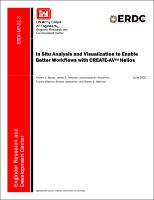Please use this identifier to cite or link to this item:
https://hdl.handle.net/11681/40846Full metadata record
| DC Field | Value | Language |
|---|---|---|
| dc.contributor.author | Bauer, Andrew C. | - |
| dc.contributor.author | Forsythe, James R. | - |
| dc.contributor.author | Haehnel, Robert B. | - |
| dc.contributor.author | Wissink, Andrew M. | en_US |
| dc.contributor.author | Jayaraman, Buvana | en_US |
| dc.contributor.author | Sitaraman, Jayanarayanan | en_US |
| dc.date.accessioned | 2021-06-03T16:48:59Z | - |
| dc.date.available | 2021-06-03T16:48:59Z | - |
| dc.date.issued | 2021-06 | - |
| dc.identifier.govdoc | ERDC MP-21-3 | - |
| dc.identifier.uri | https://hdl.handle.net/11681/40846 | - |
| dc.identifier.uri | http://dx.doi.org/10.21079/11681/40846 | - |
| dc.description | Miscellaneous Paper | en_US |
| dc.description.abstract | The CREATE-AV™ Helios CFD simulation code has been used to accurately predict rotorcraft performance under a variety of flight conditions. The Helios package contains a suite of tools that contain almost the entire set of functionality needed for a variety of workflows. These workflows include tools customized to properly specify many in situ analysis and visualization capabilities appropriate for rotorcraft analysis. In situ is the process of computing analysis and visualization information during a simulation run before data is saved to disk. In situ has been referred to with a variety of terms including co-processing, covisualization, coviz, etc. In this paper we describe the customization of the pre-processing GUI and corresponding development of the Helios solver code-base to effectively implement in situ analysis and visualization to reduce file IO and speed up workflows for CFD analysts. We showcase how the workflow enables the wide variety of Helios users to effectively work in post-processing tools they are already familiar with as opposed to forcing them to learn new tools in order post-process in situ data extracts being produced by Helios. These data extracts include various sources of information customized to Helios, such as knowledge about the near- and off-body grids, internal surface extracts with patch information, and volumetric extracts meant for fast post-processing of data. Additionally, we demonstrate how in situ can be used by workflow automation tools to help convey information to the user that would be much more difficult when using full data dumps. | en_US |
| dc.description.sponsorship | United States. Army. Corps of Engineers. | en_US |
| dc.format.extent | 17 pages / 3.22 MB | - |
| dc.format.medium | - | |
| dc.language.iso | en_US | en_US |
| dc.publisher | Information Technology Laboratory (U.S.) | en_US |
| dc.publisher | Cold Regions Research and Engineering Laboratory (U.S.) | - |
| dc.publisher | Engineer Research and Development Center (U.S.) | - |
| dc.relation.ispartofseries | Miscellaneous Paper (Engineer Research and Development Center (U.S.)) ; no. ERDC MP-21-3 | - |
| dc.relation.isversionof | Bauer, Andrew C., James R. Forsythe, Jay Sitaraman, Andrew M. Wissink, Buvaneswari Jayaraman, and Robert B. Haehnel. "In Situ Analysis and Visualization with CREATE-AV™ Helios." In AIAA Scitech 2021 Forum, p. 0943. 2021. https://doi.org/10.2514/6.2021-0943 | - |
| dc.rights | Approved for Public Release; Distribution is Unlimited | - |
| dc.source | This Digital Resource was created in Microsoft Word and Adobe Acrobat | - |
| dc.subject | High performance computing | en_US |
| dc.subject | Computer simulation | en_US |
| dc.subject | Prototypes | en_US |
| dc.subject | Engineering | en_US |
| dc.subject | Web-based user interfaces | en_US |
| dc.title | In situ analysis and visualization to enable better workflows with CREATE-AV™ Helios | en_US |
| dc.type | Report | en_US |
| Appears in Collections: | Miscellaneous Paper | |
Files in This Item:
| File | Description | Size | Format | |
|---|---|---|---|---|
| ERDC MP-21-3 .pdf | 3.22 MB | Adobe PDF |  View/Open |